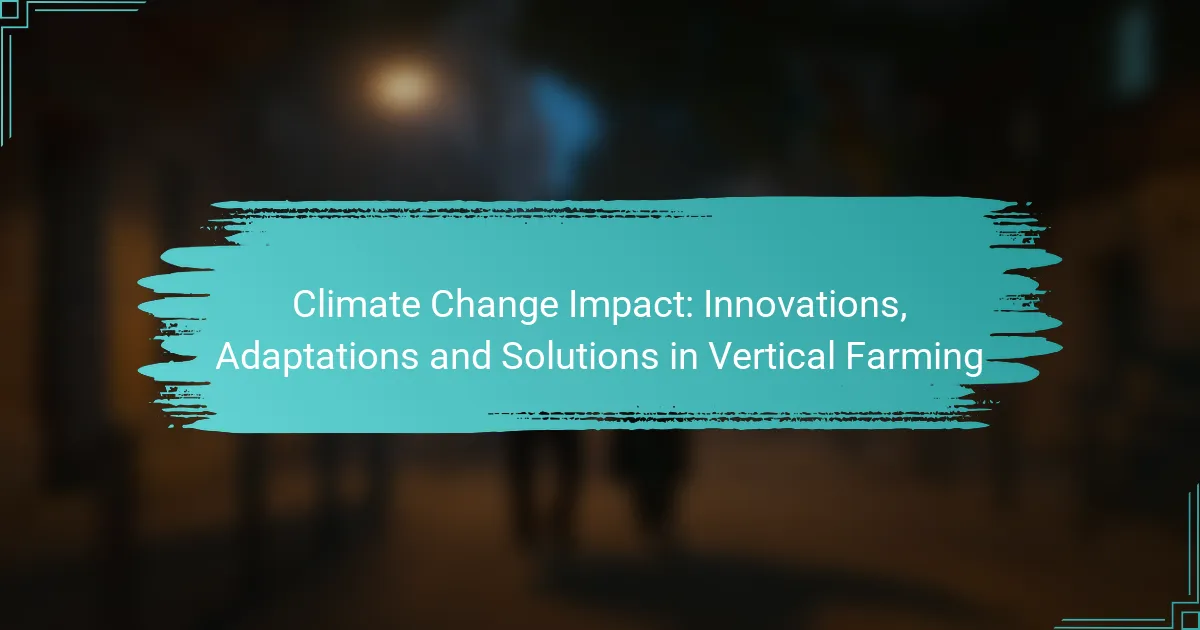Vertical farming represents a transformative approach to agriculture that addresses the challenges posed by climate change, particularly in urban areas. By optimizing space and minimizing resource use, this innovative method not only supports local food production but also significantly reduces transportation emissions. With advancements in technology and adaptive strategies, vertical farming is poised to enhance efficiency and sustainability in food systems worldwide.

How does vertical farming mitigate climate change in urban areas?
Vertical farming helps reduce the impact of climate change in urban settings by utilizing space efficiently and minimizing resource consumption. This innovative agricultural method allows for local food production, reducing transportation emissions and promoting sustainability.
Reduced carbon footprint
Vertical farming significantly lowers the carbon footprint associated with traditional agriculture. By growing food in urban environments, it eliminates the need for long-distance transportation, which is a major source of greenhouse gas emissions. Additionally, many vertical farms use renewable energy sources, further decreasing their overall carbon output.
Implementing energy-efficient technologies, such as LED lighting and smart climate control systems, can enhance these benefits. Urban vertical farms can achieve carbon neutrality or even become carbon sinks, depending on their energy sources and operational practices.
Efficient water usage
Vertical farming employs advanced irrigation techniques that drastically reduce water consumption compared to conventional farming. Hydroponics and aeroponics systems can use up to 90% less water, making them ideal for areas facing water scarcity. These systems recycle water, minimizing waste and ensuring that plants receive optimal hydration.
Urban vertical farms can also integrate rainwater harvesting systems, further enhancing their sustainability. This practice not only conserves water but also reduces the burden on municipal water supplies, making it a practical solution for cities.
Minimized land use
Vertical farming maximizes food production in limited urban spaces by stacking crops vertically, allowing for high-density cultivation. This method requires significantly less land than traditional farming, which is crucial in densely populated areas where land is at a premium.
By utilizing rooftops and abandoned buildings, vertical farms can transform underused spaces into productive agricultural sites. This not only helps meet local food demands but also contributes to urban greening efforts, improving air quality and enhancing biodiversity.
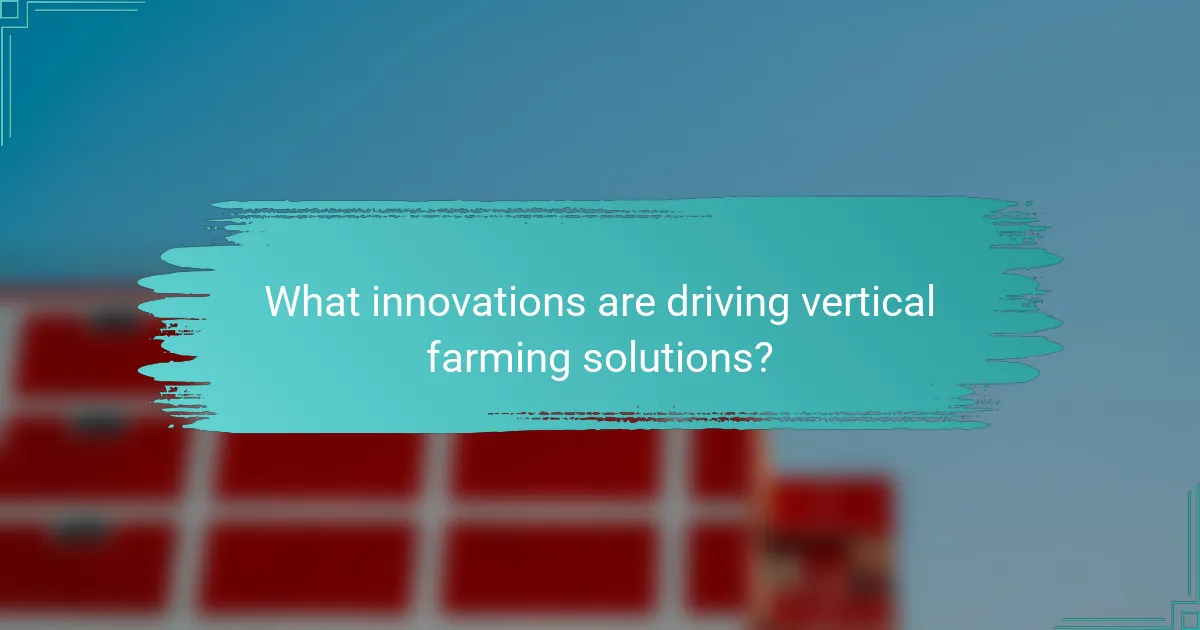
What innovations are driving vertical farming solutions?
Innovations in vertical farming are primarily focused on enhancing efficiency, reducing resource consumption, and maximizing yield. Key technologies such as hydroponic systems, aeroponic technology, and advancements in LED lighting are transforming how food is grown in urban environments.
Hydroponic systems
Hydroponic systems allow plants to grow in nutrient-rich water rather than soil, which can significantly reduce the space and resources needed for cultivation. This method can increase growth rates and yields, making it ideal for urban farming where space is limited.
Types of hydroponic systems include nutrient film technique (NFT), deep water culture (DWC), and aeroponics. Each system has its own advantages and challenges, such as initial setup costs and maintenance requirements, which should be carefully considered based on the specific farming goals.
Aeroponic technology
Aeroponic technology involves growing plants in an air or mist environment, allowing for optimal oxygen exposure and nutrient absorption. This method can use up to 90% less water than traditional farming, making it highly sustainable.
Implementing aeroponics requires precise control over environmental factors such as humidity and nutrient delivery. While the initial investment can be higher compared to hydroponics, the potential for faster growth and higher yields can offset these costs over time.
LED lighting advancements
Advancements in LED lighting technology have revolutionized vertical farming by providing energy-efficient, customizable light spectrums that enhance plant growth. LEDs can be tailored to emit specific wavelengths that promote photosynthesis, leading to healthier plants and improved crop quality.
Using LEDs can significantly reduce energy costs compared to traditional lighting systems, with many growers reporting savings of up to 50%. When selecting LED systems, consider factors such as light intensity, spectrum, and energy consumption to optimize growth while managing operational expenses.
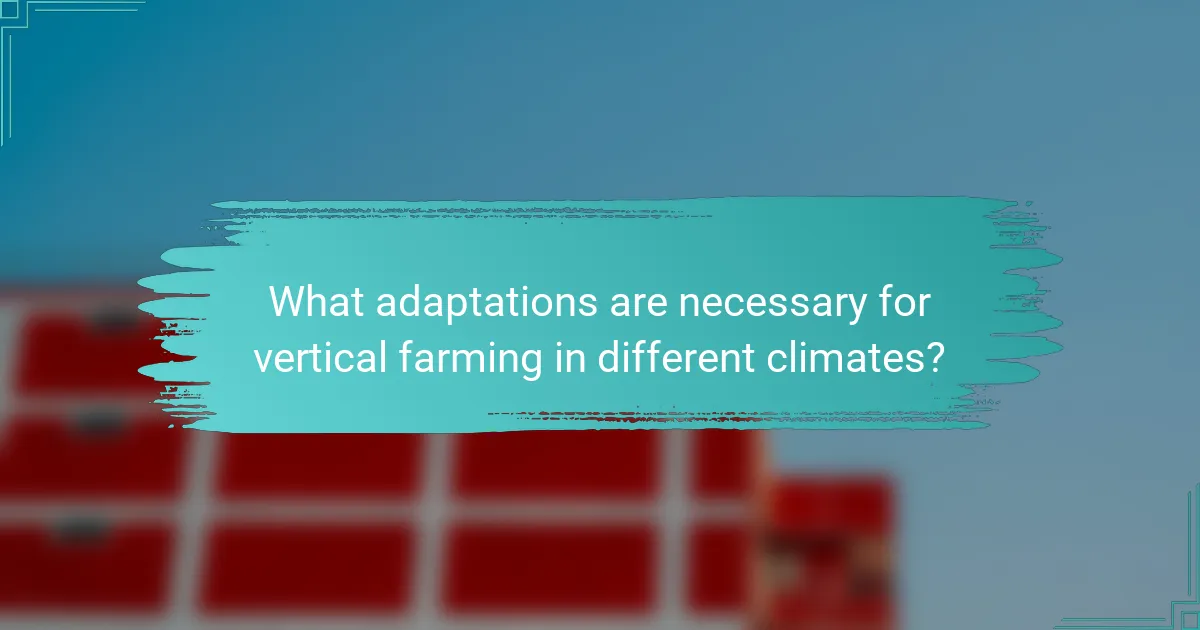
What adaptations are necessary for vertical farming in different climates?
Vertical farming must adapt to varying climate conditions to optimize growth and resource use. Key adaptations include temperature control systems, humidity management techniques, and crop selection tailored to local environments.
Temperature control systems
Effective temperature control is crucial for vertical farming, especially in extreme climates. Systems such as HVAC (heating, ventilation, and air conditioning) or geothermal heating can maintain optimal growing temperatures, typically between 20-25°C for most crops.
In colder regions, insulation and heat retention strategies are essential to reduce energy costs. Conversely, in hotter climates, cooling systems, including evaporative cooling or reflective materials, can help maintain a stable environment.
Humidity management techniques
Humidity levels significantly affect plant health and growth rates. In humid climates, dehumidifiers and proper ventilation are necessary to prevent mold and disease. Maintaining humidity between 40-60% is generally ideal for many crops.
In drier areas, misting systems or humidifiers can help achieve the required moisture levels. Regular monitoring of humidity with sensors can provide real-time data to adjust systems accordingly, ensuring optimal conditions for plant growth.
Crop selection for local conditions
Choosing the right crops is vital for successful vertical farming in diverse climates. Local conditions, including temperature, humidity, and light availability, should guide crop selection. For instance, leafy greens thrive in cooler, humid environments, while tomatoes and peppers prefer warmer conditions.
Researching local market demands and climate adaptability of crops can enhance profitability. Utilizing native or climate-resilient varieties can also reduce resource needs and increase yield stability in changing conditions.
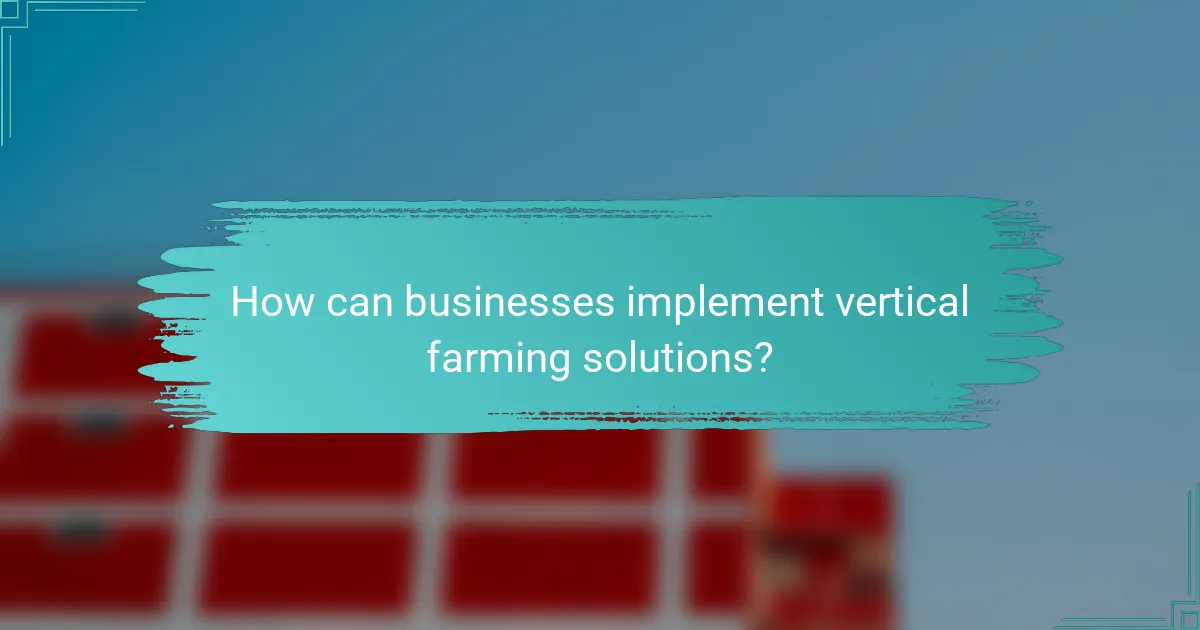
How can businesses implement vertical farming solutions?
Businesses can implement vertical farming solutions by integrating innovative agricultural practices that maximize space and resources. This approach involves utilizing technology, forming partnerships, and engaging with the community to create sustainable food production systems.
Partnerships with local governments
Forming partnerships with local governments is essential for businesses looking to implement vertical farming. These collaborations can provide access to funding, regulatory support, and land use permissions, which are critical for establishing a vertical farm.
Businesses should actively engage with local authorities to understand zoning laws and agricultural regulations that may affect their operations. This can lead to streamlined processes and potential incentives for sustainable practices.
Investment in technology
Investing in technology is crucial for the success of vertical farming solutions. This includes advanced systems for hydroponics, aeroponics, and climate control, which can significantly enhance crop yields and reduce resource usage.
Businesses should consider adopting automation tools for monitoring and managing growth conditions, as well as data analytics to optimize production. Initial investments can vary widely, but focusing on scalable technologies can help manage costs effectively over time.
Community engagement strategies
Implementing community engagement strategies is vital for the acceptance and success of vertical farming initiatives. Businesses can host workshops, farm tours, and educational programs to raise awareness about the benefits of vertical farming.
Building relationships with local residents and stakeholders can foster support and collaboration. Additionally, involving the community in decision-making processes can lead to tailored solutions that meet local needs and preferences.
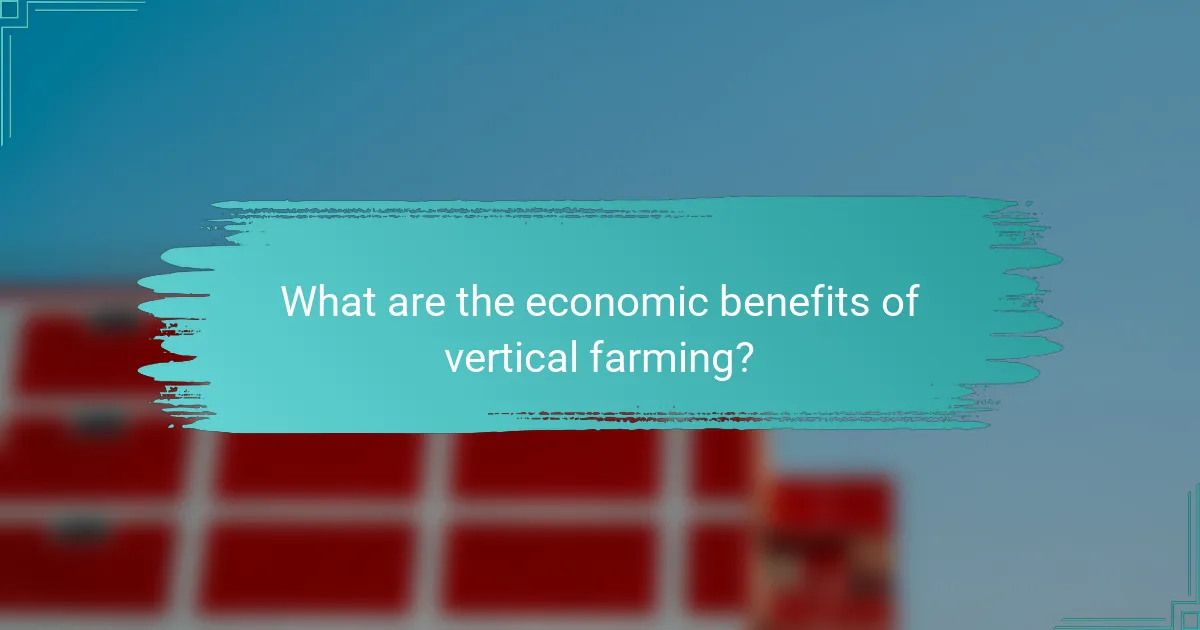
What are the economic benefits of vertical farming?
Vertical farming offers significant economic advantages, including job creation, reduced transportation costs, and enhanced food security. By utilizing innovative growing techniques in urban settings, it can transform local economies and promote sustainability.
Job creation in urban areas
Vertical farming can generate numerous job opportunities in urban environments, ranging from agricultural technicians to logistics and marketing roles. These farms often require a skilled workforce to manage advanced technologies, leading to the creation of high-quality jobs.
Additionally, as vertical farms expand, they can stimulate local economies by providing employment for residents and reducing urban unemployment rates. This shift can enhance community engagement and promote local food systems.
Reduction in transportation costs
By situating farms within or near urban centers, vertical farming significantly cuts down on transportation expenses associated with delivering produce from rural areas. This proximity allows for fresher produce, which can be delivered to consumers in a matter of hours rather than days.
Lower transportation costs not only benefit consumers through reduced prices but also decrease the carbon footprint associated with food distribution. This efficiency can lead to more sustainable urban food systems and improved access to fresh produce.
Increased food security
Vertical farming enhances food security by providing a reliable source of fresh produce in urban areas, reducing dependence on external food supplies. This localized approach ensures that communities have access to nutritious food year-round, regardless of climate conditions or supply chain disruptions.
Moreover, vertical farms can operate in various environments, including areas with poor soil quality or limited arable land. This adaptability allows for increased resilience in food production, contributing to overall food stability in urban populations.
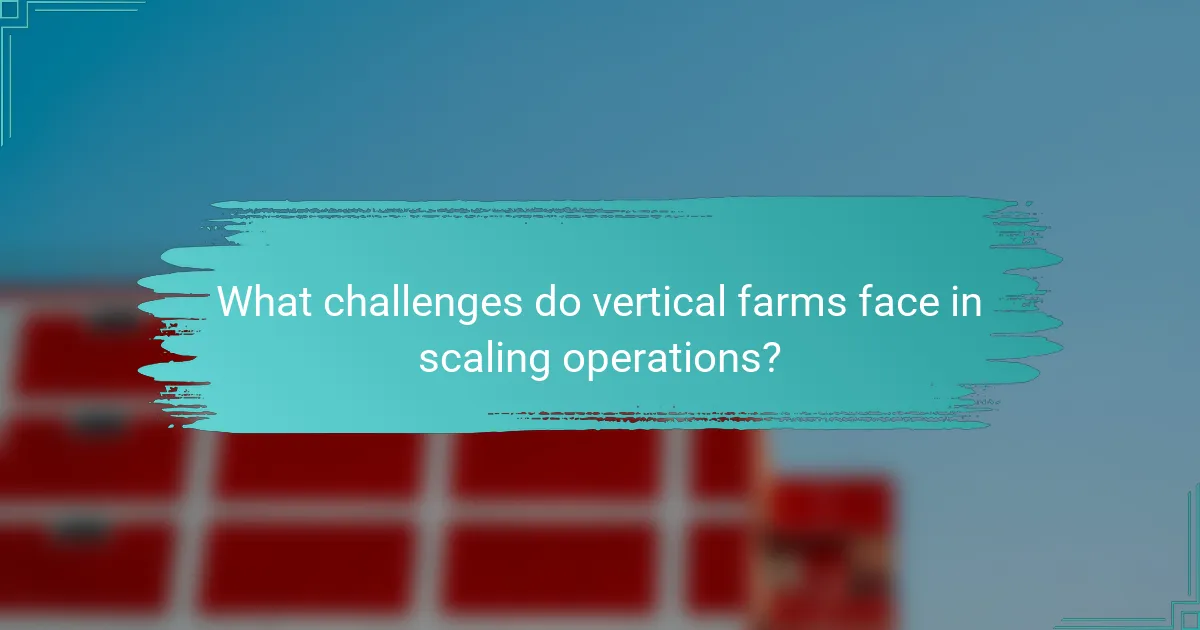
What challenges do vertical farms face in scaling operations?
Vertical farms encounter several key challenges when attempting to scale their operations, including high initial costs, technological complexities, and regulatory hurdles. These factors can hinder growth and profitability, making it essential for operators to navigate them effectively.
High initial investment costs
The initial investment for vertical farming can be substantial, often requiring hundreds of thousands to millions of dollars. This includes costs for advanced lighting, climate control systems, and hydroponic or aeroponic setups. Operators must carefully evaluate financing options and potential return on investment to ensure sustainability.
To mitigate these costs, some farms explore partnerships or grants from agricultural innovation programs. Additionally, phased investments can help manage financial risk while gradually expanding operations.
Technological complexities
Vertical farming relies on sophisticated technology for optimal plant growth, including sensors, automation, and data analytics. These technologies can be challenging to implement and maintain, requiring skilled personnel and ongoing training. Operators must stay updated on advancements to remain competitive.
Investing in user-friendly systems and integrating training programs for staff can help ease the technological burden. Collaborating with tech providers for support can also enhance operational efficiency.
Regulatory hurdles
Regulations surrounding food safety, zoning, and agricultural practices can pose significant challenges for vertical farms. Compliance with local laws is crucial, as violations can lead to fines or operational shutdowns. Understanding the regulatory landscape is essential for successful scaling.
Farm operators should engage with local agricultural departments and industry associations to stay informed about relevant regulations. Developing a compliance checklist can streamline adherence to legal requirements and minimize risks.
